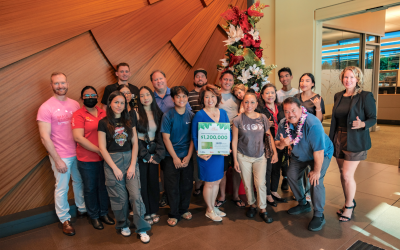FISHING MEANS FOOD FACT SHEET
If expanded, the entire 200-mile limit (US Exclusive Economic Zone) surrounding the
Northwest Hawaiian Island (NWHI) chain, will be off limits to Hawaii’s fishermen,
The expansion represents a 350 percent increase in the no-fishing zone, twice the size of
Texas. This places a staggering and disproportionate ocean conservation burden on
Hawaii – Larger states like California have only nine percent and Oregon less than three
percent whereas Hawaii would bear 67 percent of the ocean conservation burden for the
entire nation.
• Eighty percent of the fish caught in Hawaii is consumed in Hawaii. We are a state that
struggles with food security. Other than fresh fish, which is 34 percent locally sourced, less
than ten percent of our food supply is locally sourced.
• The Hawaii longline fishery is the most important local food producer in the state with an
annual farm-gate or dock-side value of over $100 million. This fishery far exceeds any
single agricultural food product in Hawaii, including sugarcane, pineapple, macadamia nuts,
coffee, and papaya.
• The Hawaii fishery has a proven, effective model for sustainable fishery management.
Hawaii’s longline fishery is among the most intensively studied, monitored and managed
fisheries in the world. This fishery is federally managed by the National Oceanic and
Atmospheric Association (NOAA) and the Western Pacific Regional Fishery Management
Council (WPRFMC).
• In 1991, NOAA and the WPRFMC created the 50-mile longline fishing exclusion zone
around Hawaii, including the NWHI chain to protect nearshore resources and habitat. This
preceded actions by President Clinton and then President Bush in 2006 that created the
PMNM on top of the existing 50-mile no fishing zone.
• NOAA scientists and managers have already determined that protections are in place for
the coral reef habitat, green sea turtles, monk seals, and seabirds within this 50-mile buffer.
Expanding the monument to 200 miles will not add to these protections because these
habitats and species live near shore and not in the deep open ocean where our longline
fishing vessels operate.
• NOAA’s own 2012 and 2014 Biological Opinions concluded that the Hawaii longline fishery
is not likely to jeopardize the continued existence of the protected species and critical
habitat in Hawaii.
• The Hawaii Longline Fishery operates in compliance with the 10 National Standards laid
out by the federal Magnuson-Stevens Sustainable Fisheries Act (MSA), the Marine Mammal
Protection Act (MMPA), the National Environmental Protection Act (NEPA), the
Endangered Species Act (ESA), the Migratory Bird Treaty Act (MBTA) and other laws that
keep this fishery operating responsibly and within sustainable limits.
• Hawaii’s 140 longline boats bring in just 1.65 percent of all big eye tuna caught in the
Pacific Ocean. Hawaii’s fishery is one of the most highly regulated in the world, with federal
observers on 100 percent of its swordfish boats and 20 percent of its ahi boats. Of the
total observed ahi catch in the Pacific, over 80 percent comes from our Hawaii fleet – so
the 1.5 percent catch represents almost all the regulated/observed catch in the entire
Pacific.
Response to Proponents’ Claims:
Claim: “Hawaii’s fishermen only take 5 percent of their total catch from the proposed
expansion zone, so this will have a minimal effect on the supply of fish and to the industry.”
Response: It’s actually 10 percent of the catch that comes from the proposed expansion area
— representing two million pounds of fish. Here’s the problem with thinking that 10 percent
is a minimal amount:
1) Any fisherman will tell you they don’t fish in the same areas today that they fished in five
years ago. What happens when the fish move to other areas in the expansion zone? Could
we see decreases of 30 or 40 percent? When the Northwest Hawaiian Island marine
sanctuary (that is now the Monument) was established, Hawaii lost 50 percent of its
bottomfish catch of our once famous deep water snappers – opakapaka and onaga and
we lost all eight of our bottomfish vessels.
2) On any given day, the fish catch comes from different areas, and availability affects
pricing. Just a week ago on the auction floor, 54 percent of that day’s catch was from the
proposed expansion area. A 54 percent decrease will undoubtedly result in increased
prices and force the use of gas treated frozen fish.
Claim: “Hawaii’s longline fishing fleet met its quota in August last year so this means the
fishermen will just take a little longer to get to their allotted catch.”
Response: The Hawaii-based US longline fleet operates mainly under the Western and Central
Pacific Fishery Commission (WCPFC). The government agencies arbitrarily dictate what
our yearly bigeye tuna quota will be through a Tropical Tuna Management Measure.
Foreign fisheries have been given much larger longline quotas due to foreign influence and
the prominence of purse-seine fishing inequity. The foreign purse-seine fleets operating
near the equator catch hundreds of thousands of tons of juvenile bigeye, while longline
fleets only target adult bigeye. This has led to a bigeye fishing issue, while the Hawaii fleet
has always been compliant and not contributing to the problem. Hawaii catches just 1.5
percent of all the bigeye tuna in the Pacific ocean.
Despite a restricted quota, the US Hawaii fleet still operates under strict domestic
management measures regulated by the NMFS and Coast Guard.
Claim: “This expansion will protect marine life that the fishermen harm – including monk seal
populations, turtles and sea birds.”
Response: Hawaii’s Longline Fishery is managed by NOAA Fisheries and the WPRFMC and is a
global model for pelagic (open ocean) fishery management for sustainability. Hawaii
fisheries are the most intensely studied, monitored and managed fisheries in the world. The
Hawaii Longline Fishery is the world’s first fishery to be scored against the United National
Food and Agriculture Organization Code of Conduct for Responsible Fisheries (FAO
Code). In 2008, the Hawaii Longline Fishery scored a 94% compliance with the FAO Code,
the world’s only international agreement on what constitutes a responsible fishery capable
of producing sustainable wild seafood.
NOAA scientists and managers have already determined in multiple studies that
protection has been achieved for the coral reef habitat, green sea turtles, monk seals and
seabirds that occur close to shore within the existing 50 mile buffer.
About Fishing Means Food
Fishing Means Food is a coalition of chefs, farmers, fishermen, business and community leaders
dedicated to preserving Hawaii’s fresh fish industry by supporting local fishermen’s access to fish
in the proposed expansion of the Papahanaumokuakea Marine National Monument




0 Comments